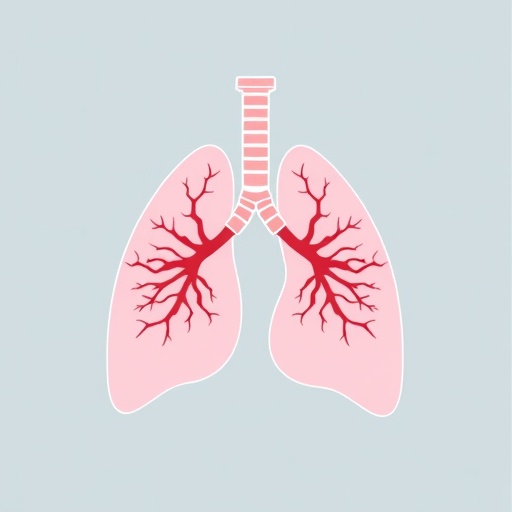
In a groundbreaking study poised to redefine our understanding of chronic respiratory diseases, researchers have uncovered compelling evidence linking antenatal inflammation to the subsequent development of late pulmonary hypertension in experimental bronchopulmonary dysplasia (BPD). This intricate investigation, published in Pediatric Research in 2025, provides unprecedented insights into how early-life inflammatory insults precipitate long-term vascular remodeling and elevated pulmonary arterial pressures, illuminating critical pathways that may one day transform therapeutic strategies for affected neonates.
Bronchopulmonary dysplasia, a debilitating lung condition primarily affecting premature infants, has long confounded clinicians due to its complex etiology and persistent sequelae. Traditionally characterized by arrested alveolar development and disrupted pulmonary vascularization, BPD’s progression to pulmonary hypertension represents a severe complication that dramatically worsens morbidity and mortality rates. The study in question exploits a sophisticated antenatal inflammation model that mimics the in utero exposure to pro-inflammatory stimuli, shedding light on how these prenatal insults induce pathological alterations well beyond the neonatal period.
Central to the investigation is the mechanistic exploration of pulmonary vascular remodeling, a hallmark of pulmonary hypertension. Findings demonstrate that antenatal inflammation triggers a cascade of molecular events, including endothelial dysfunction, smooth muscle cell hyperplasia, and extracellular matrix deposition within the pulmonary artery walls. These pathological changes culminate in sustained vasoconstriction and increased pulmonary vascular resistance, setting the stage for elevated arterial pressures that manifest clinically as late-onset pulmonary hypertension in the postnatal phase.
.adsslot_ypaXIjNeux{ width:728px !important; height:90px !important; }
@media (max-width:1199px) { .adsslot_ypaXIjNeux{ width:468px !important; height:60px !important; } }
@media (max-width:767px) { .adsslot_ypaXIjNeux{ width:320px !important; height:50px !important; } }
ADVERTISEMENT
Crucially, the research delineates the role of inflammatory mediators—cytokines, chemokines, and growth factors—that orchestrate the maladaptive vascular responses. Elevated levels of tumor necrosis factor-alpha (TNF-α), interleukin-6 (IL-6), and transforming growth factor-beta (TGF-β) were identified in antenatally challenged subjects. These molecules promote inflammatory cell recruitment and activate fibroblast proliferation, driving fibrotic remodeling that compromises the compliance of pulmonary vessels. This intricate interplay between inflammation and fibrosis underscores a potential therapeutic window for pharmacologic intervention.
Moreover, the study intricately maps the temporal progression of these vascular changes, revealing that the pathological surge in pulmonary arterial pressure is not a transient phenomenon but a chronic condition emerging weeks after birth. This delayed onset implies that antenatal inflammation initiates a latent cascade of vascular pathology, which likely remains subclinical before progressing to overt pulmonary hypertension. Such insights emphasize the necessity for vigilant long-term monitoring of at-risk neonates, even in the absence of immediate postnatal symptoms.
From a cellular perspective, the investigation highlights endothelial progenitor cell dysfunction as a pivotal contributor to impaired pulmonary vascular repair processes. Normally involved in endothelial regeneration, these progenitors exhibit reduced mobilization and altered phenotype following antenatal inflammatory insult, exacerbating vascular injury and promoting maladaptive remodeling. This discovery opens avenues for regenerative medicine approaches aimed at restoring endothelial integrity to mitigate disease progression.
The researchers employed a meticulously designed animal model that faithfully recapitulates the complexity of human BPD compounded by antenatal inflammation. Using this model, they quantified hemodynamic parameters through advanced techniques such as right heart catheterization and echocardiography, correlating functional impairments with histopathological findings. This comprehensive methodology ensures translational relevance, enhancing the predictive value of their findings for clinical scenarios.
Further molecular analyses delved into the activation of hypoxia-inducible factors (HIFs), which exacerbate vascular remodeling by promoting angiogenic imbalances and metabolic dysregulation under inflammatory conditions. The synergistic effect of hypoxia and inflammation appears to potentiate vascular smooth muscle proliferation and resistance to apoptosis, thereby sustaining a vicious cycle of pathological vascular remodeling and pulmonary hypertension. Unraveling these interconnected pathways provides a framework for combination therapeutic strategies targeting multiple pathogenic axes.
Beyond its immediate scientific contributions, the study resonates with public health implications by identifying antenatal inflammation—often linked to maternal infections or systemic inflammatory conditions—as a preventable risk factor for severe neonatal pulmonary complications. This knowledge advocates for enhanced prenatal care protocols incorporating infection control, inflammation monitoring, and possibly prophylactic interventions to curtail downstream vascular pathology in the fetus.
Technologically, the research leveraged cutting-edge transcriptomic and proteomic profiling to uncover signatures of inflammatory and remodeling pathways, revealing potential biomarkers for early diagnosis and severity stratification of pulmonary hypertension in BPD patients. The identification of these molecular fingerprints paves the way for personalized medicine approaches, enabling clinicians to tailor surveillance and treatment based on individual risk profiles.
In addition, the study highlights opportunities for repurposing existing anti-inflammatory and anti-fibrotic agents to attenuate or reverse the trajectory of pulmonary hypertension development when administered during critical windows after antenatal inflammation exposure. Such therapeutic strategies could profoundly alter the clinical course for preterm infants burdened by this devastating disease, reducing the long-term burden on healthcare systems and improving quality of life.
Importantly, this research challenges prevailing notions that pulmonary hypertension in BPD predominantly arises from postnatal factors such as oxygen toxicity and mechanical ventilation injury. By illuminating antenatal inflammation as a primary instigator of late pulmonary vascular disease, it shifts the paradigm towards earlier intervention points and broadens the scope of preventive and therapeutic research.
The implications of this study extend into the realm of developmental biology, elucidating how prenatal inflammation disrupts the finely tuned processes governing pulmonary vascular morphogenesis and homeostasis. This disruption not only impacts neonatal outcomes but also potentially predisposes survivors to chronic pulmonary vascular diseases in adulthood, emphasizing the life-course dimension of antenatal insults.
As researchers continue to unravel the complexities of perinatal lung disease, this landmark study stands as a testament to the power of integrative, multidisciplinary approaches combining immunology, vascular biology, neonatology, and translational science. By decoding the elusive link between antenatal inflammation and late pulmonary hypertension in BPD, the work charts a promising course towards innovative interventions that might one day eradicate this life-threatening complication.
In summary, the meticulous investigation led by Dias Maia and colleagues has unveiled critical mechanistic insights into how antenatal inflammatory exposure precipitates late pulmonary hypertension within the context of experimental bronchopulmonary dysplasia. The detailed characterization of molecular and cellular pathways underlying vascular remodeling provides a robust foundation for future targeted therapies and reinforces the imperative for proactive prenatal care to mitigate inflammation-induced neonatal pulmonary vascular disease.
Subject of Research: Development of late pulmonary hypertension following antenatal inflammation in bronchopulmonary dysplasia
Article Title: Development of late pulmonary hypertension after antenatal inflammation in experimental bronchopulmonary dysplasia
Article References:
Dias Maia, P., Seedorf, G., Gonzalez, T. et al. Development of late pulmonary hypertension after antenatal inflammation in experimental bronchopulmonary dysplasia. Pediatr Res (2025). https://doi.org/10.1038/s41390-025-04223-6
Image Credits: AI Generated
DOI: https://doi.org/10.1038/s41390-025-04223-6
Tags: antenatal inflammation effectsbronchopulmonary dysplasia researchchronic respiratory conditions in infantsendothelial dysfunction in pulmonary hypertensionlate pulmonary hypertensionlong-term effects of prenatal inflammationneonatal morbidity and mortalityneonatal respiratory diseasespro-inflammatory stimuli in pregnancypulmonary vascular remodeling mechanismssmooth muscle cell hyperplasiatherapeutic strategies for BPD



